Health & Education
We all want the best care possible for our horses. The Heath & Education section covers both Learning Institutions, Organizations as well as many sources for equine assistance including Veterinarians and Farriers.
For those who want a to formally study horses, the Education section includes College Riding, Equine Studies, and Veterinary Schools. Learn about the wide variety of horses in the Horse Breeds section. Supplements and Treatments Therapy are also included in the section.
Everyone can learn from Fine Art and there are some specialty Museums that might surprise you.
Horses as a therapy partner enrich the lives of the disabled. These facilities are listed in our Therapeutic Riding section. To help children and young adults build confidence and grow emotionally, please see the resources available on the Youth Outreach page.
Looking for a place to keep your horse? You can find it in the Horse Boarding section. Traveling? Find a Shipping company or Horse Sitting service if your horse is staying home!
Want to stay up to date with the latest training clinics or professional conferences? Take a look at our Calendar of Events for Health & Education for the dates and locations of upcoming events.
Do we need to add more? Please use the useful feedback link and let us know!
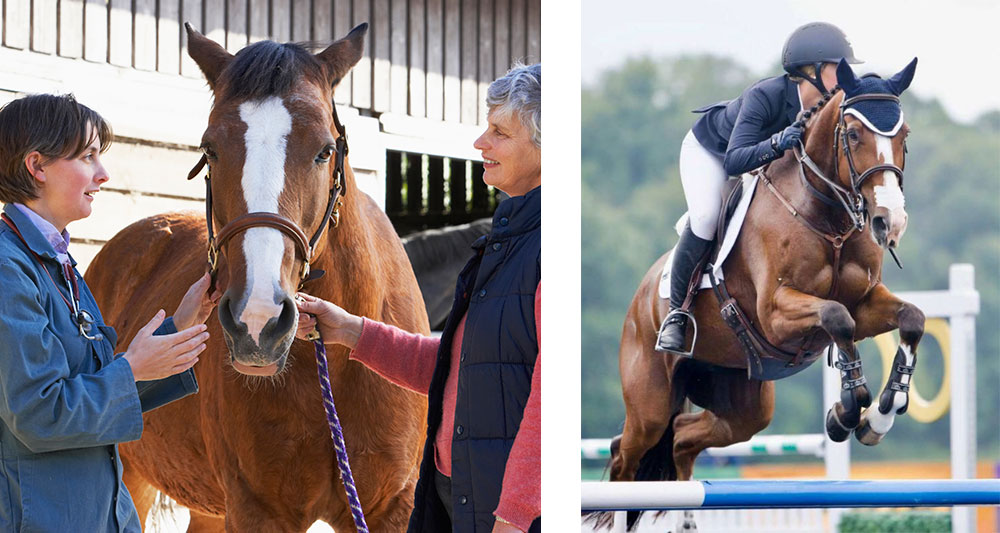
Veterinarians in Wyoming
- Animal Medical Center of Wyoming, 200 E. Lakeway Road, Gillette, WY 82718
- Bear River Veterinary Clinic, 619 Almy Road 107, Evanston, WY 82930
- Blue Sky Animal Hospital, 26850 Kettle River Blvd., Wyoming, MN 55092
- Bluffs Vet Clinic, 722 West 7th Street, P.O. Box 550, Pine Bluffs, WY 82082
- Boulder Veterinary Clinic, 337 State Highway 353, Boulder, WY 82923
- Bridger Animal Hospital & Haystack Pet Resort, 127 Jepperson Road, P.O. Box 777, Thayne, WY 83127
- Carbon County Veterinary Hospital, 921 Airport Road, Rawlins, WY 82301
- Fish Creek Veterinary Clinic, P.O. Box 1814, 5325 3/B Ranch Road, Wilson, WY 83014
- Foothills Veterinary Services, 1937 Double Eagle Drive, Sheridan WY 82801
- Frontier Veterinary Clinic, 501 E. Riding Club Road, Cheyenne, WY 82009
- Laramie Peak Veterinary Associates, 28 W Frontage Road, Wheatland, WY 82201
- Mountainaire Animal Clinic, 1801 Yellowstone Road, Rock Springs, WY 82901
- Powder River Veterinary Hospital & Supply PC, 537 Sussex Lane, Kaycee, WY 82639
- Ten Mile Hoslitic Veterinary Care, 4701 W Yellowstone Hwy Mills, Casper, WY 82604-2209
- The Stock Doc, 3700 Riverview Road, Riverton, WY 82501
- Wyoming Equine Veterinary Practice, Bruce Connally DVM, 7364 Nebraska Way, Longmont, CO 80504
- Wyoming State Veterinary Laboratory, 1000 E. University Ave., Laramie, WY 82071
When looking for a horse veterinarian, prioritize their experience with horses, relevant certifications, good horse handling skills, a confident and calm demeanor, access to specialists for complex cases, a clear communication style, and positive recommendations from other horse owners in your area; also consider their availability, practice setup, and pricing structure to ensure they fit your needs.
Key qualities
Equine specific expertise: Ensure the vet has significant experience treating horses, as equine medicine differs from other animal practices.
Relevant certifications: Check if the vet holds certifications from organizations like the American Association of Equine Practitioners (AAEP) or has additional specialties like lameness, dentistry, or reproduction.
Good horse handling skills: A skilled vet should be comfortable and confident around horses, handling them calmly during procedures.
Communication skills: Choose a vet who explains diagnoses and treatment plans clearly and answers your questions thoroughly.
Access to specialists: Consider if the vet has a network of specialists they can refer to for complex cases.
Reputation and referrals: Ask other horse owners in your area for recommendations about the vet's competence and reliability.
Other factors to consider
Practice setup: Decide if you prefer a solo practitioner or a larger clinic with multiple vets depending on your needs.
Availability: Check the vet's practice hours and on-call availability for emergencies.
Cost and pricing structure: Inquire about the vet's fees for routine procedures and potential treatments to ensure they fit your budget.
Facility and equipment: Evaluate the vet clinic's facilities, including the availability of necessary diagnostic tools and equipment.
An equine veterinarian is a veterinarian who specializes in the care of horses. They are trained to diagnose and treat a wide range of horse health problems, including:
- Lameness
- Digestive problems
- Respiratory problems
- Reproductive problems
- Infectious diseases
- Neurological disorders
- Surgical conditions
Equine veterinarians also play a role in preventive care for horses, such as vaccinations, deworming, and dental care.
Equine veterinarians are different from small animal veterinarians in a number of ways. First, equine veterinarians must have a strong understanding of horse anatomy and physiology. Horses are large animals, and their anatomy and physiology are different from those of small animals such as cats and dogs.
Second, equine veterinarians must be able to work with horses in a variety of settings, including farms, racetracks, and horse shows. This requires them to be able to handle horses safely and effectively.
Finally, equine veterinarians must be familiar with a wide range of horse breeds and disciplines. This is because different breeds of horses are prone to different health problems, and different disciplines place different demands on horses' bodies.
Here are some specific examples of the tasks that an equine veterinarian may perform:
- Perform physical examinations
- Diagnose and treat diseases and injuries
- Perform surgery
- Vaccinate horses
- Deworm horses
- Provide dental care
- Advise horse owners on nutrition and management
Equine veterinarians play an important role in the health and well-being of horses. They provide a wide range of services to help horses stay healthy and perform at their best.
Here are some of the key differences between equine veterinarians and small animal veterinarians:
- Species: Equine veterinarians specialize in the care of horses, while small animal veterinarians specialize in the care of cats and dogs.
- Anatomy and physiology: Horses are large animals with anatomy and physiology that is different from that of small animals. Equine veterinarians must have a strong understanding of horse anatomy and physiology in order to provide effective care.
- Work environment: Equine veterinarians often work in a variety of settings, such as farms, racetracks, and horse shows. Small animal veterinarians typically work in veterinary clinics or hospitals.
- Breeds and disciplines: Equine veterinarians must be familiar with a wide range of horse breeds and disciplines. Small animal veterinarians typically focus on a smaller range of breeds and disciplines.
Overall, equine veterinarians and small animal veterinarians play important roles in the health and well-being of animals. They are both highly skilled and knowledgeable professionals who are dedicated to providing the best possible care to their patients.
You can find more informative articles in our section on Health & Education. While you're here be sure to check out our Curated Amazon Store.

Your horse feeding regimen will need to change in winter. Learn how so, from equine nutritionists and a veterinarian.
While impressively stout yet entirely fragile, horses require a great level of care, especially as it relates to their nutrition over the winter.
“Many horse owners may not realize they actually need to feed horses differently in the wintertime than they do in the summertime,” Jyme Nichols, PhD, director of nutrition at Stride Animal Health, shared in an interview with Valley Vet Supply.
For a better understanding, continue learning with these three facts and insights from equine nutrition experts, Dr. Nichols and Brittany Rahm, nutrition consultant at Stride Animal Health.
Fact 1: A Horse’s “Thermoneutral Zone” Directly Impacts Their Nutritional Needs.
“The first thing that I think is important for everybody to understand is a term that sounds a little bit intimidating -- thermoneutral zone,” Dr. Nichols said. “This is basically the temperature outside in which a horse can maintain their own core body temperature without having to exert any extra effort to regulate either their heat loss or heat gain.”
Horses in the United States have an average thermoneutral zone between 40 and 80 degrees, which means horses near the low end of their thermoneutral zone will have to use extra energy (thus calories) to maintain heat.
To identify whether your horse is outside of their thermoneutral zone, “You want to pay attention to whether or not they're using any natural defenses to that cold weather,” encourages Rahm.
These natural defenses can include:
- Shivering
- Standing with tail to the wind, head lowered
- Seeking shelter
Dr. Nichols followed up with, “Anytime you combine cold temperatures on top of moisture -- wind, ice and of course snow-- a horse will have to increase their heat production and will need to consume more calories. Additionally, young horses or underweight horses are going to hit that lower, critical temperature and get colder faster than a mature horse or a horse that's going into wintertime with really good body condition,” Dr. Nichols said.
An especially important detail for those traveling for competitions or pleasure with their horses is that it takes two weeks to a full month for horses to readapt to a new ambient temperature.
“When traveling, be mindful if you're going a long distance or to a region that has a very different temperature range than what you're coming from -- your horse may struggle a little bit more to retain heat or try to get rid of it -- depending whether you're going to a colder climate or a hotter climate,” said Dr. Nichols.
Fact 2: A Horse’s Feed Sources Will Help Them Maintain Warmth, in Addition to Weight.
It’s important to understand “metabolic heat production” as it relates to increasing a horse’s feed during cold temperatures.
Dr. Nichols explained, saying, “Think of a horse’s digestive system, or their hind gut, as a furnace. The more the microbes in the horse’s hind gut are able to digest and ferment -- especially fibers -- the more heat that can be generated for that horse. That's part of what goes into keeping them warm.”
Fact 3: As Weather Changes, So Should a Horse’s Diet, But Not in the Way Some May Think.
“A lot of times, people can get hung up thinking, ‘I need to change up [my horse’s] grain, or I need to change how much grain I feed,’” Dr. Nichols said. However, is either necessary? Not exactly, but there are some other aspects for horse owners to consider.
While a well-meaning sentiment, increasing grain can be harmful to a horse’s health -- heightening colic risk and more -- and secondly, doing so may not be enough to help a horse maintain their warmth when they need it most.
“Increasing the amount of hay is the best way to increase heat production and keep a horse warm during winter,” Dr. Nichols said. “Horses will naturally increase the amount of hay that they eat, based on the temperatures dropping.”
Regarding how much more hay to provide -- remember that the average thermoneutral zone for horses in the U.S. is between 40 and 80 degrees. Dr. Nichols said, as a general rule of thumb, for every one-degree Fahrenheit below the lower range of 40 degrees, horses will need an extra 200 calories.
“So, to put that in perspective, your average hay is going to have between 800 to 1,000 calories per pound. Let's say you've got a 10-degree drop -- you're going to need an extra 2,000 calories. All I did there was just take that 10 degrees times 200 calories, and that gets me to 2,000 calories, which is roughly 2 to 3 lbs. extra hay per day. So, if you're feeding small square bales of grass hay, that's probably going to be an extra flake, maybe an extra two flakes.”
Horse owners will need to increase their horse’s hay intake, but what about their grain? When the temperatures drop, upping feed is a common practice (but not recommended). Dr. Nichols shared two specific horse health examples, should horses be fed either a fortified feed or cereal grains, such as whole corn and oats.
Example 1, fortified feed increase -- say horsemen are feeding a fortified grain at a recommended level of 4 lbs. per day, then increase by 1 lb. per day. That feed is designed to meet all vitamin mineral requirements, amino acid requirements, etc., at 4 lbs. per day. While that extra pound may not be more harmful, it will provide some extra calories but the calories will be more quickly digested. This means the increased grain does not provide horses with long-term heat production, like hay does.
Example 2, cereal grain increase -- say horsemen are feeding a whole corn/oat mix at 4 lbs. per day and decide to double it. Corn and oats are really high in starches and sugars, which puts a really heavy load of sugar on the digestive tract that the small intestine can't digest very well, very quickly. You can then have an overspill of starch into the hind gut of the horse, impacting the balance of the good bacteria in that gut and presenting colic issues; it can also cause founder or laminitis issues in some horses.”
“You want to keep your grain level the same. If you're going to up anything, the most important thing to do is up that hay and consider a supplement that will keep them drinking, like Hydrate + Recover,” Rahm said.
For senior horses or horses with poor dental conditions, both Rahm and Dr. Nichols recommend feeding forage pellets, such as Timothy or alfalfa hay pellets, or even beet pulp shreds, which all have similar benefits as long-stem hay forage.
“For horses who are underweight, it is important to try to improve their body condition, which will support their thermoregulation and overall health. In addition to increasing their total hay intake, we recommend adding a high-quality protein and energy supplement to help support healthy weight gain,” said Tony Hawkins, DVM, technical service veterinarian at Valley Vet Supply.
Bundle up, stay safe, and keep in mind these three facts to help your horse weather the winter. Continue learning about horse care at ValleyVet.com.
All photos courtesy of Valley Vet.
This article originally appeared on Valley Vet and is published here with permission.
There are more informative articles in our section on Health & Education. Be sure to check out our Curated Amazon Store for Feed, Supplements and Horse Farm supplies.
"Is there anything I can do to prevent pregnancy loss in my mare?" presented by Dr. Mandi de Mestre, professor of biomedical sciences at the Baker Institute for Animal Health at #CornellVet, recorded November 21, 2023 via Zoom.
⚠️ Please note: This presentation includes equine pregnancy loss images that may be upsetting to some viewers. Please view at your own discretion.
In this seminar, Dr. de Mestre discusses the possible reasons why a mare suffers pregnancy loss, including which ones are the most commonly found in clinical cases of pregnancy loss and what you should be looking out for. She highlights new findings on novel genetic reasons a pregnancy might fail and how such cases can be identified. The talk ends with how we can use all this information in the management of mares to avoid or minimize the impact of pregnancy loss on mare fertility.
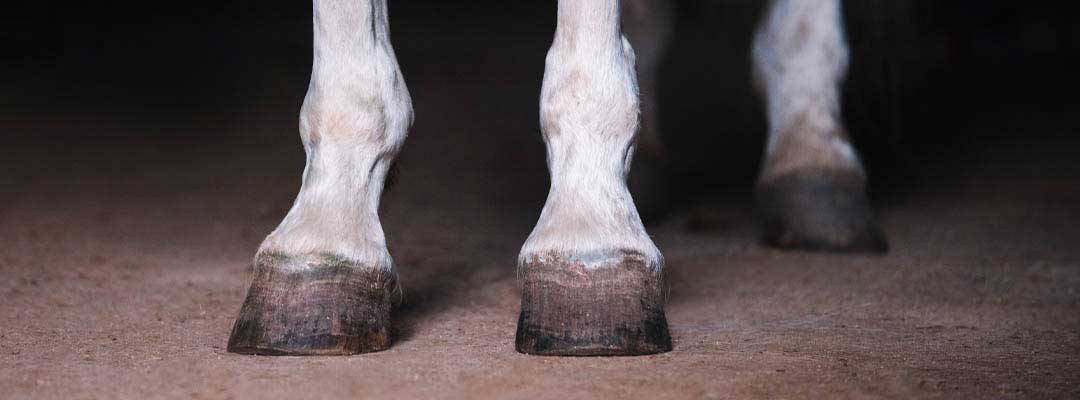
Help support healthy hooves with these insights.
Regular hoof care is of upmost importance to your horse’s well-being and performance, whether you’re an avid competitor or weekend trail blazer. For insights on hoof care and answers to some common questions, we visited with Valley Vet Supply Technical Service Veterinarian, Tony Hawkins, DVM.
For a healthy horse, hoof care is important. But, why?
“If their hooves are not well-maintained, horses can have significant stress on their ligaments, including the suspensory ligament, which can cause prominent lameness issues,” warns Dr. Hawkins. “Proper hoof care also helps address cushioning and proper biomechanics of the horse; anytime we throw that off, horses can be predisposed to conditions like navicular syndrome -- a degenerative condition of structures within the horse’s heel, often leading to chronic forelimb lameness.”
How often do horses need their hooves trimmed?
Horse hoof trimming needs will differ depending on the individual horse, and even the time of year. With this in mind, a good rule of thumb is to trim or shoe a horse every six to eight weeks. A University of Minnesota Extension report authored by Mary Boyce, DVM, states, “The horse’s hooves grow slower in the winter,” and during this time a trim or new set of shoes may only be needed every six to 12 weeks.
Do horses need to be shod?
Some horses need shoes on them. Horse owners will need to consider conditions both at home and when traveling, such as when standing on hard concrete and gravel, which can make horses more tender-footed.
Hoof boots are becoming all the more popular, with great designs like Easyboots for horses.
What is the common hoof ailment, thrush in horses, and how does one recognize it?
Dr. Hawkins says, “Thrush is a mixed bacterial, fungal infection of the horse’s frog (triangular in shape, extending mid-heel to toe). Thrush happens when horses’ hooves get wet and stay wet for extended periods. Their soft tissue of the hoof becomes weak and the bacteria, which is just naturally present in the environment, can invade that susceptible tissue, causing an infection further into the frog sulcus area. If we don't stay on top of it, thrush can become a huge problem before we really even realize there is one. If we have thrush issues, and wet conditions, we really need to focus on getting horses to a dry area. That's going to be a very important part of their therapy. You can put all of the products on it possibly that you want, but if we don't dry out that tissue, we may not see a successful treatment response.”
Thrush in horses’ hooves can cause them to be sore and tender-footed. If the horse isn’t treated, the condition can be drastic. The condition is especially prevalent during seasons with more rainfall. Shop thrush medication.
What causes hoof cracks in horses?
The culprit of hoof cracks in horses, according to the University of Minnesota Extension, includes dry or inconsistent weather and rainfall, extended trimming intervals and poor hoof health. Learn about the different kinds of hoof cracks and how to prevent them.
How can hoof supplements help?
A horse’s hoof health benefits from specific ingredients in hoof supplements, including Biotin, Iodine, Methionine and Zinc.
Dr. Hawkins says, “Hoof supplements help support the right level of vitamins (most importantly, Biotin), minerals and nutrition that support strong, healthy hoof growth. In return, that's going to help prevent issues, such as hoof cracks, and support strong laminar attachments to help horses avoid laminitis and founder issues.”
When should horse owners involve their veterinarian?
“Getting a veterinarian's input is valuable when it comes to challenges impacting the hoof,” Dr. Hawkins said. “Many hoof issues can preface systemic disease processes; getting a complete physical exam on the horse will help rule that out. For example, laminitis is considered a sign of Cushing's disease, also known as PPID (Pituitary Pars Intermedia Dysfunction), which is the most common hormonal disorder affecting horses and ponies. If it's severe enough, their veterinarian could recommend getting some radiographs of the leg and lower foot, which would be valuable information for their farrier to have and best correct the problem.”
Continue reading about horse hoof health in this Q&A with a longtime farrier. Shop hoof supplements available from veterinarian-founded ValleyVet.com.
This article originally appeared on Valley Vet and is published here with permission. Valley Vet Supply was founded in 1985 by veterinarians for people just like you - people who want the very best for their four-legged friends and livestock.
All photos courtesy of Valley Vet.
There are more informative articles in our section on Health & Education.
The EIE Amazon Store also offers great products for Hoof Care. Check it out!
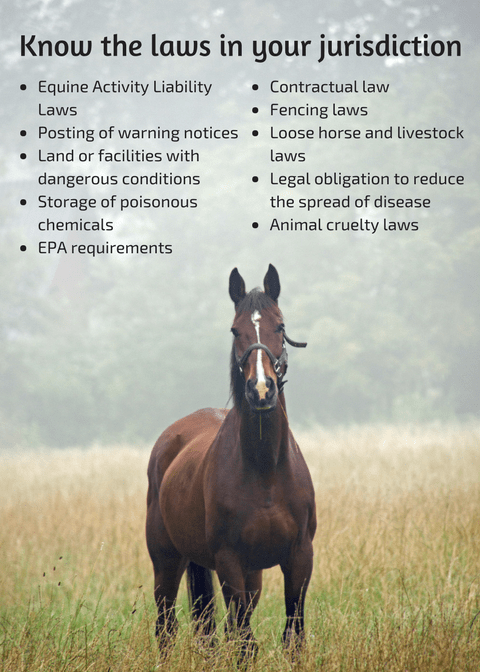
By By Jill Montgomery
Most riders are well aware of the risks that come with horseback riding. According to a study published by the National Institutes of Health, one in five riders (20%) will suffer a serious horse-related injury that requires medical care or hospitalization. In addition, an equine professional such as a riding instructor, may face legal action if someone is injured in their care. We should all pause for a moment to consider exactly what that means. However, there is a lot we can do, and that we should be doing, to manage the risks in equine activities.
Equine professionals should create an environment where clients can enjoy their program and have the necessary tools to make their experiences with horses safe; this leads to repeat customers and more business. Conversely, the old adage “bad news travels fast” is never truer than when a client is injured in your riding program, and it could damage your reputation.
With such a broad range of potential problem areas, you may ask, “Where do I start?”
Key areas for managing risk in a horse program include:
- The horse’s training and suitability for the activity,
- The education and expectations for the participants behavior
- The education and expectations for the behavior of staff;
- The equipment used in the equine activity; and
- The environment in which the activity takes place.
Ensure that your well-trained staff and clients practice safety every day with every interaction with a horse or another rider. Train your horses to accept the tasks asked of them calmly and obediently. Check tack and equipment every time it is used, and repair or replace damaged equipment. Plan for and create policies for dealing with environmental risks.
The equine professional must also constantly educate participants about equine behavior and continually identify, assess, and analyze risks associated with the services they offer. However, even with good management, training, and preparation some equine behaviors are largely unpredictable and can cause injury to a client. Unpredictable behaviors such as bucking, shying, rearing, bolting, tripping, or stumbling are collectively referred to as inherent risks.
Legal Liability
Almost all states now have limited liability statutes to offer protection from legal liability for the inherent risks of equine activities. While these laws don’t prevent injured parties from suing, they are very helpful to defendants and limit the complaints to the exceptions in the law, which vary by state. Equine professionals need to know their specific state laws. However, despite these statutes, the best defense is to take practical steps to avoid injuries.
Risk management in regards to legal action can be described as a three-legged stool, and removing any of the legs from this stool leaves you in an unstable position. These three legs include:
- Acknowledgement of Risk or Liability Waiver—More than just a release of liability, this document should educate the client about the risks they may be exposed to in your program. Your attorney and insurance company should review and sign off on the language. Everyone in your operation that comes into contact with horses should be taught the material and be asked if they understand it before they sign. Keep the signed document as a permanent record.
- Liability Insurance—Ensure the activities in your operation are adequately covered with insurance. To find the correct policy, work with an insurance professional who understands your operation.
- Refrain from Negligent Behavior—Negligence is an exception in every state’s statutes. Be familiar with the laws in your jurisdiction that effect your program. Know what your community expects from you as a service provider. Build a culture at your facility that is safety aware using training, procedures, and policies. Post barn rules so everyone sees them and can enforce them. Document your safety efforts.
Identifying Risk Scenarios
One technique for prioritizing risk management is assessing the relationship between the likelihood (frequency) of a risk and the severity of the damage if it occurs. Identify the high frequency risks in your program and always be prepared to handle them should they occur. Examples of risk scenarios ranked using frequency versus severity, include:
- The Barn Fire—Any barn fire can be catastrophic. However, if you have a disaster and emergency plan in place, it could save lives and reduce the amount of damage.
- A Loose Girth/Cinch—This type of tack failure, as well as others, could result in the saddle slipping and/or a fallen rider. Yet, this type of incident is avoidable. Always check if the saddle is off center or if it has moved forward or backward from its normal position before having a rider mount. You can also reduce this risk by adjusting the cinch as needed, adding breast collars for increased stability, and by helping the rider to stay centered on the horse.
- Horse Steps on Handler’s Toes—This is one of the most common risks, although it’s often not severe. Teach your horses to be respectful of their handlers’ space and teach handlers to be aware of the potential for crushed toes and to wear proper footwear.
In Summary
Providing clear and consistent messaging to your clients and staff about your safety policies and practices will help build a safety-conscious culture and create a foundation for your horse program’s continued success.
About the Author Jill Montgomery is CEO of JRAM Enterprises, Inc., Equine Business Consulting. She is also a CHA Certified Instructor, CHA Certified Equine Facility Manager, and a Region 9 Director. JRAMenterprises.com.
This article originally appeared on Certified Horsemanship Association and is published here with permission.
There a more informative articles in our section on Health & Education.
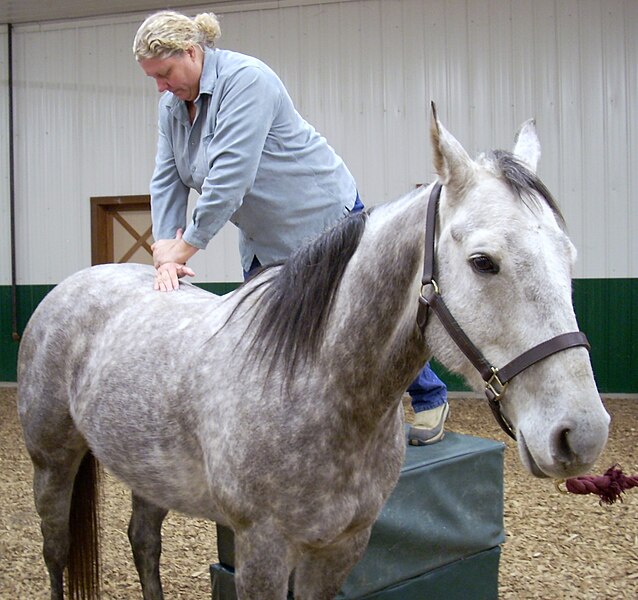
A horse chiropractor is a veterinarian who specializes in treating a horse's musculoskeletal, neurological, joint, and skeletal disorders. They use controlled force to improve a horse's movement and function, and to reduce pain.
Some signs that a horse may need chiropractic care include:
- Poor performance
- Stiffness or lameness
- Pain in the neck, back, or tail
- Abnormal posture
- Discomfort when saddled
- Difficulty bending to one side
Equine chiropractors use a type of manual therapy called equine chiropractic. This involves applying short, high velocity, low amplitude thrusts to specific regions of the horse's body. The goal is to change the horse's joint structures, muscle function, and neurological reflexes.
To become an equine chiropractor, you must first earn a Doctor of Veterinary Medicine (D.V.M.) or a Doctor of Chiropractic (D.C.) degree. After that, you can attend an advanced education program to become an animal chiropractor.
Horses with heavy workloads or those being shown may need to see an equine chiropractor every three weeks. Horses that are used for pleasure riding or are in less intense training may only need to see a chiropractor every three months.
How do I know if my horse would benefit from chiropractic care?
Horses that may benefit from chiropractic care may present with many signs, the most common of which is pain. Horses with back pain often express this in their posture or in their refusal to work. A horse’s attempts to compensate for the pain by changing its posture and way of going can result in other problems such as joint problems.
The following symptoms in a horse may indicate pain:
- Reduced performance
- Abnormal posture
- Snapping and pinning back its ears when being saddled
- Insubordination when being ridden
- Attempting to free itself by throwing its head back or up or by hollowing the back
- Swishing its tail and pinning back its ears
- Disobedience when jumping
- Difficulties with collected or lateral gaits
- Changes in behavior
- Frightened or painful facial expression
- Sensitivity to touch
Alterations of the spine can affect muscle coordination and mobility of the horse, thereby causing decreased performance. The following signs may occur:
- Unleveled gait rhythm
- Irregularity of gait which cannot be assigned to a particular leg or gait
- Stiffness when the horse leaves the stable
- Stiffness when bending and in its general posture
- Muscular atrophy
- Difficulty engaging the hindquarters
- Shortened stride in one or more legs
- Overall decreased range of motion in gait
- Difficulty flexing the poll
- Lameness
- Horse pulls against one rein
- Rider is seated off center due to the horse
- The back does not swing
Photo credit Dr Dennis Eschbach, CC BY-SA 3.0
Chiropractor - Education- Chiropractor - General Information
- Chiropractor - Providers - International
- Chiropractor - Providers - United States
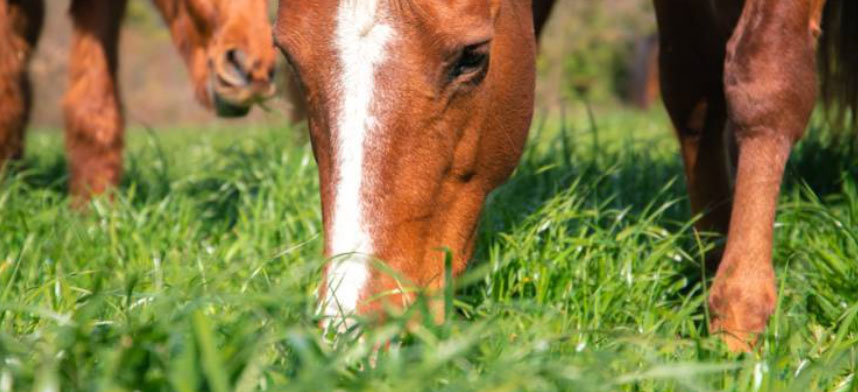
Photo courtesy of Kentucky Equine Research By Kentucky Equine Research Staff
Horse owners are often advised to manage obese horses with caloric restriction, which typically includes limiting access to pasture. Because grazing, access to free-choice exercise, and social interactions all allow horses to express normal behaviors, researchers are now wondering if there is a way to restrict pasture access without affecting welfare?*
Obese horses have an increased risk of metabolic syndrome characterized by insulin dysregulation. In turn, horses with increased levels of circulating insulin are at risk of developing hyperinsulinemia-associated laminitis, a painful and life-threatening condition of the feet.
“Weight management is by far the most important and most widely recommended approach to managing insulin dysregulation and obesity,” explained Ashley Fowler, Ph.D., a nutritionist for Kentucky Equine Research. “However, restricting grazing with muzzles or drylots can sometimes be difficult for owners to implement due to lack of available land for sacrifice areas or because some horses are incredibly clever at removing their grazing muzzles.”
When given the chance, horses spend about two-thirds of their day grazing, and according to veterinary researchers, grazing is a “central and innate facet of equine behavior.”*
Restricting grazing may lead to frustration as well as problematic or abnormal behavior, including aggression and stereotypic behaviors.
Two systems are often recommended for restricted grazing:
- Strip grazing, which involves limiting horses to a specific grazing area that is increased in size over time by moving fencing to reveal ungrazed grass.
- Track systems that involve creating a track around the perimeter of the grazing area that can be gradually increased in size.
To determine the effects of these two restricted grazing systems on behavior of outdoor-living ponies, researchers used 24-hour electronic surveillance and GPS data loggers attached to a halter to track activity levels. Data was collected over four weeks.
Key findings included:
- Ponies spent most of their time grazing regardless of the system;
- More ponies showed agonistic behavior (i.e., conflict or fighting) in the strip grazing system than ponies in the track system; and
- Ponies moved significantly more in the track system. “This could be due to a more enriched environment, less competition over resources or improved social cohesion,” said the research team.
“This research highlights the potential benefits of a track system on weight management, by both limiting grass access and encouraging more movement,” explained Fowler.
“Regardless of which method horse owners use to limit pasture access for weight management, horses fed calorie-restricted diets should still be fed a vitamin-mineral supplement or ration balancer to ensure daily dietary requirements are met,” advised Fowler.
*Kirton, R., I. Sandford, E. Raffan, S. Hallsworth, O.H.P. Burnam, and R. Morgan. 2024. The impact of restricted grazing systems on the behaviour and welfare of ponies. Equine Veterinary Journal:14411.
Read more: Observing Horse Behavior in Restricted Grazing Scenarios
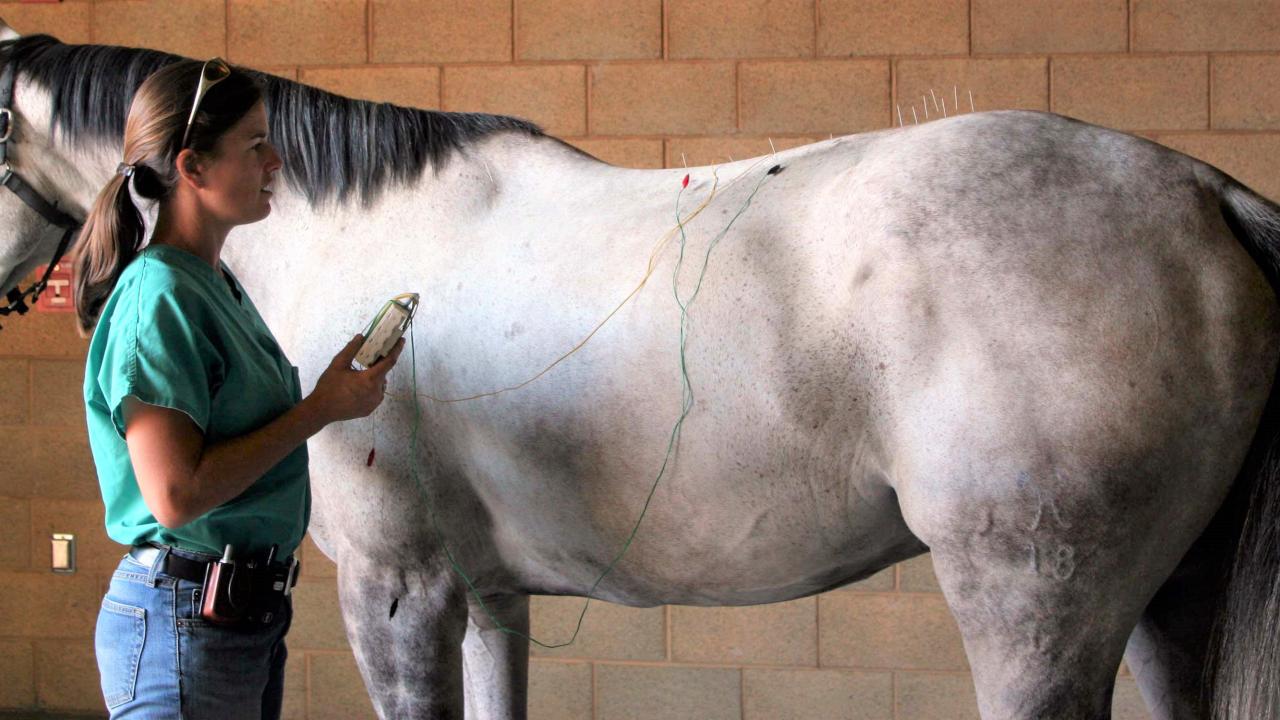
Photo Credit UC Davis Veterinary Medicine Acupuncture has been used to treat various medical conditions in humans and animals for more than 3,000 years. Horses were among the first animals treated with acupuncture due to their importance in warfare and farming. Today, equine acupuncture is commonly incorporated in the treatment of a number of conditions, especially musculoskeletal disorders and back pain.
The ancient Chinese discovered and described hundreds of acupuncture points (acupoints) in humans and animals. Modern research shows that acupoints are located in areas with a high density of free nerve endings, mast cells, small arterioles and lymphatic vessels. Stimulation at acupoints induces the release of beta-endorphins, serotonin and other neurotransmitters and can produce local, remote, and/or systemic effects. The use of acupuncture for pain relief is well supported by modern research studies. The effects of acupuncture on internal organs and on “balancing” the body as a whole are less understood, and more research is necessary to fully explain this ancient therapy.
The benefits of acupuncture have been widely recognized and integrated into Western veterinary and human medical practices. In November 1997, the National Institutes of Health (NIH) convened a panel of scientists to review the effectiveness of acupuncture. The result was the first formal endorsement of acupuncture by the NIH, stating: “There is sufficient evidence of acupuncture’s value to expand its use into conventional medicine and to encourage further studies of its physiology and clinical value.”
Acupuncture is a sought after treatment by horse owners due to its demonstrated safety and minimal unwanted side effects. It is well tolerated by most horses and provides a drug-free approach to address musculoskeletal pain that can enhance equine performance. This is particularly attractive for competitors who must adhere to show association-mandated prohibited substance policies. Aside from the needles, acupuncture does not require any specialized equipment, making it easier to perform in a variety of environments than some traditional methods.
Acupuncture can be used for a wide variety of issues.
Acupuncture can be extremely useful for pain. Besides pain relief, acupuncture may also have an impact on inflammation, which is ideal for horses with acute injuries and arthritis. It's thought that, by helping to return the nervous system to homeostasis, acupuncture may also help with the immune system and many other organ systems.
Your horse may also benefit from acupuncture's ability to increase microcirculation. This refers to the circulation of blood through your horse's smallest blood vessels -- the venules, metarterioles, terminal arterioles, and capillaries. They're located throughout your horse's body including in his or her organ tissue and stimulation of increased circulation can lead to improved wound healing, improvements in laminitis, and other great benefits.
Acupuncture for horses is a therapeutic technique that involves inserting fine needles into specific points on a horse's body to treat a variety of conditions:
- Pain relief: Acupuncture can help reduce pain and inflammation.
- Improved function: Acupuncture can help restore function to the body.
- Muscle relaxation: Acupuncture can help relax or stimulate muscles.
- Decreased swelling: Acupuncture can help decrease swelling.
- Organ function: Acupuncture can help affect organ function.
Acupuncture is a safe procedure when performed by a qualified veterinarian. It's often used in conjunction with other conventional veterinary treatments.
Here are some things to know about acupuncture for horses:
- Acupoints
There are 173 acupuncture points in animals, and each meridian has multiple acupoints. - De-Qi
When a needle is inserted, the patient experiences a sensation called "De-Qi" that indicates an acupoint has been stimulated. - Treatment plan
The number, size, and length of needles used is determined by observing the De-Qi reaction. - Treatment time
Some results can be seen immediately, but others may require several treatments. - Combination therapy
Acupuncture can be combined with medications such as local anesthetics or anti-inflammatories.
Photo Credit Photo Credit UC Davis Veterinary Medicine.
Acupuncture - General Information- Acupuncture - Education
- Acupuncture - Providers
- When EPM Strikes
- Evaluating Pasture Quality for Horses
- Winter Water Requirements for Horses
- Enjoy a More Serene Ride
- Lean Times, Lean Horses? Three Easy Ways Purina Can Help
- Purina's MQ Systemiq Probiotic Supplement
- Beyond Expectations - Book Trailer
- Finding My Stride with Therapeutic Riding - An Excerpt from Beyond Expectations
- Celebrity Supporters of the Seen Through Horses Campaign! (1:56)
- On to Safer Pastures: Protecting Horses from Poisonous Plants
- Survey Finds Half of Horse Owners Unaware of Lesser Known Stressors
- Study: Intestinal Microbiome of Foals May Predict Future Racing Success
- Intra-articular Approaches to Osteoarthritis - Cornell Equine Seminar (Oct 2024)
- What to Do When Your Horse Ride Goes Wrong
- ICONS, Renegades, Mavericks, & Forces of Nature - Photographer Drew Doggett’s Latest Series
- A Grand National Melee - An Excerpt from the Novel The Horseman’s Tale by Tom Equels
- Minimally Invasive Surgery in the Abdomen - Cornell Equine Seminar
- Get to know...Mette Moe Mannseth, Master Trainer (11:26) - Horses of Iceland
- Autumnal Horse Care: Six Considerations
- Uncovering Secrets | Seen Through Horses Campaign (2:56)
Our Mission — Serving the professional horse person, amateur owners, occasional enthusiasts and sporting interests alike, the goal is to serve all disciplines – which often act independently yet have common needs and values.
Equine Info Exchange is totally comprehensive, supplying visitors with a world wide view and repository of information for every aspect related to horses. EIE provides the ability to search breeds, riding disciplines, horse sports, health, vacations, art, lifestyles…and so much more.
EIE strives to achieve as a source for content and education, as well as a transparent venue to share thoughts, ideas, and solutions. This responsibility also includes horse welfare, rescue and retirement, addressing the needs and concerns of all horse lovers around the world. We are proud to be a woman-owned business.

































